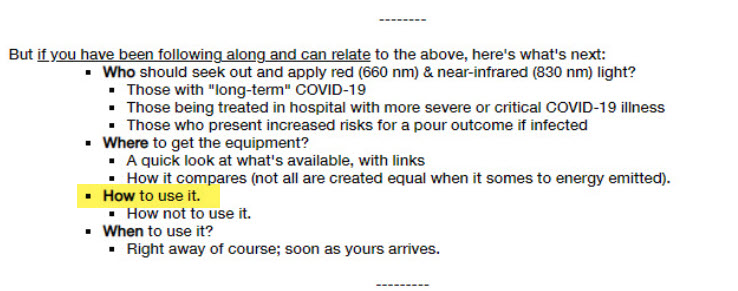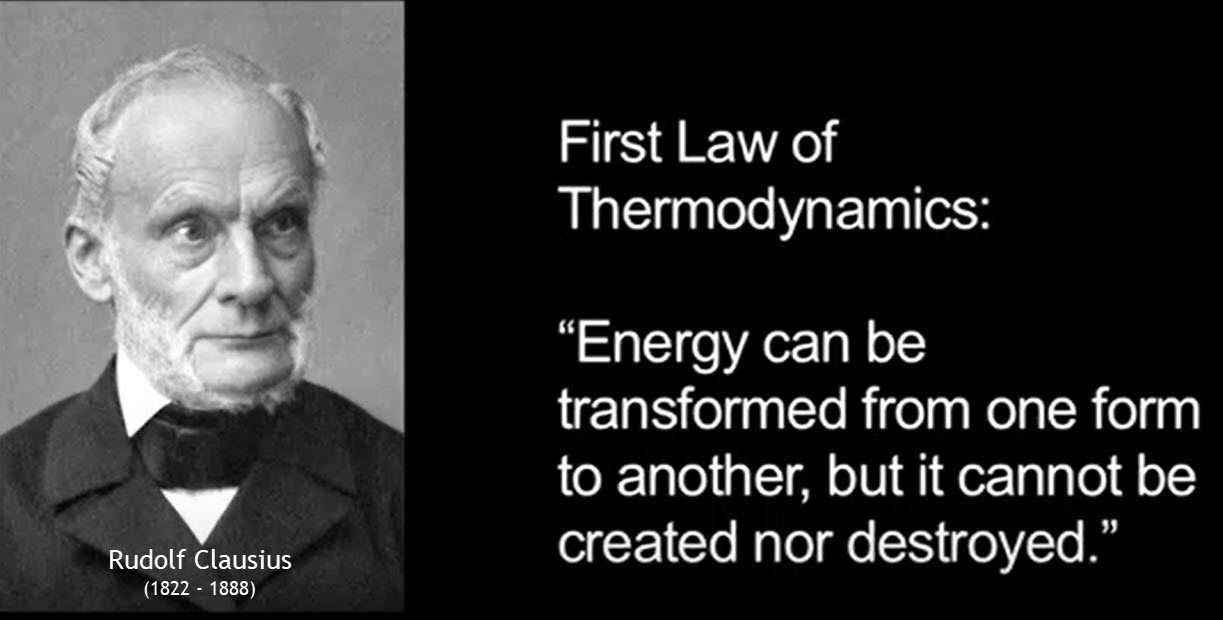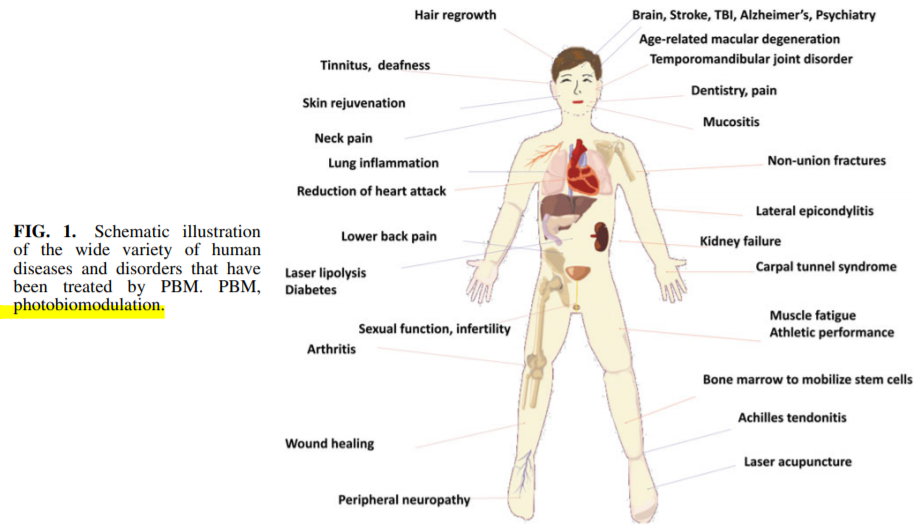Into Practice: 3. How ?
LTCOVID.com
Thanks for visiting!
To translate this page, select your
language from the dropdown menu below:
Realization
Lost? Then click on the 'LOST: SHOW THE MAP' link in the above menu.
HOW ?
We're seeking to restore depleted energy.
We are not seeking to create it.
Certainly not seeking to destroy it.
We're going to transfer it. Dr. Clausius would agree that's possible.
We have an energy source: Red (660 nm) & Near-infrared (810 - 830 nm) LEDs, gathered together in some physical format or application as introduced previously.
We are going to transform energy from certain wavelengths found in sunlight, into another form. The light won't do that. Mitochondria in our cells will do that. Recently, these mitochondria, our cellular "power houses" have taken a beating. Their Electron Transport Chain (ETC) is having a hard time completing the transfer of electrons to the turbine (ATPSynthase) that cranks out our only energy currency: Adenosine Tri-Phosphate (ATP). We are going to point our lights at Cytochrome C Oxidase at the end of that ETC in each mitochondria. We are going to connect, like a cable to a car's dead battery, our photonic energy. Just imagine! If that doesn't merit a movie scenario, what does?!
So know that today, you have been given the starring role in this blockbuster!
Aim Your Light
But at what? At some location found towards the top of the "long-term" COVID-19 list of symptoms. That's Question 39, for example: Symptoms during this illness.
So if one's hair has been falling out in clumps because follicular cells of the scalp have mitochondria that are just all pooped out. Aim it there.
"What?! Aim it at my head?!"
Absolutely.
And if your primary bothersome symptom this day is muscular aches and pains, aim your light at those.
Breathing still not normal? Still short of breath? Your thorax awaits the light.
Recall that the symptom with the highest frequency of appearance from our questionnaire is:
"Marked Fatigue." That's a whole body complaint. So treat your whole body. One region after another.
And if your primary symptom today is depression and tearfulness, your head should again be getting the light. "Brain fog" sounds like something originating above the level of the neck as well. And if red & near-infrared light helps for traumatic brain injury, why not give it a try for "brain fog"? We learned here and accept that this is an emotional as well as physical illness, even if the latter predominates. Shine a light on both.
In fact, aim has previously been taken at many parts of the body, and many disease entities, and with success.
For reasons that should be apparent, "long-term" COVID-19 is not on the diagram below.
One day soon, it may well be.
(click image below to enlarge it)
All that's missing is applying what the responses to our Quesionnaire have so clearly instructed.
SIDE EFFECTS
Before advancing to side effects, it is logical to quickly present at least one example of research that confirms that there are in fact any effects at all of these wavelengths of light on cells of the body. Here is a good example of such research, identifying effects.
The safety of these wavelengths has been emphasized over and over by various sources, treating various ailments. Is anyone 'official' following this along to confirm safety or risks? Yes, the Scientific Committee on Health, Environment and Emerging Risks (SCHEER) of the European Union has been following for some time. Their focus is on LEDs for lighting in the home, so not perfectly related, but they too are attracted to the appliances we have presented previously.
But if you transfer with your light a bit too much energy, or for too long, a bit of an over-energized sensation may become apparent. Athletes usually like this, and so are increasingly red light buffs. Also useful for sports injuries. What would you prefer? Slightly hyper, or suicidally depressed? Among our respondents, 56.1% voiced Depression/ Sadness. 59.9%, Tearfulness. 12.1%, Thoughts of Harming Self. 10.6%, Suicidal Thoughts. Turn the light on it.
And of course, a whole body treatment aimed at "Marked Fatigue," if effective, should only lighten one's overall mood as well.
Back To The Science
This transfer and transformation of energy that we're looking for, depends on:
-
-
- irradiance (from the light source, W/ m² or mW/ cm²) - which varies with distance
- energy density (Joules/ cm²) - depends on irradiance and time
-
To be complete, the above depend on the wavelength (or frequency) of the source. But we've already set that to be a fixed variable by our choice of our red and near-infrared device with its LEDs.
We're not talking Gamma, nor X-ray, nor UV waves, and thank goodness that's true.
If you have gotten this far and still need more science that explains Low Level Light Therapy, this Nuts and Bolts article may be of use.
DETAILS
-
-
- Time: get a kitchen timer or equivalent. To begin with, to gain confidence with the process, set it for 6 minutes. Its probably not a good idea to turn on the light, fall asleep under it, then wake up 4 hours later. Use a timer. Once you have the hang of this, try 10 minutes where you're aiming it. As explained, weaker devices, but for longer periods, may still get the desired result. Low doses of light are surprisingly often more beneficial than high doses.
- Distance: One frequently finds 24 inches (2 ft or 60 cm) from the source of light, suggested. As we saw previously, irradiance drops off significantly between 15 and 30 cm (6 and 12 inches) for the devices we studied. So placing the light 6 to 12 inches away should be perfectly safe. And if it drops down to 3 inches or even touches your skin, not to panic! It won't harm a thing. You won't get an unpleasant burn. Infrared lights are a source of heat. This is not. Some devices come equipped with cooling fans because small amounts of heat are created. Not much.
- Frequency: You may find that you like the effect so much that you write on your calendar to do this 6 times a day. Probably a mistake. In the treatment of several different ailments, (head trauma patients for example), patients came to a clinic perhaps 3 days a week. If you start with every day, after a week try dropping back a bit. You can even skip a few days and come back to it. Nothing lost. Recall that you are using energy to driving things in your body that depend on synthesis of proteins and a repair process. That usually takes time. It's a bit like waiting to see results of an exercise program or diet. Not instantaneous. Like those, Low Level Light Therapy (LLLT) isn't instantaneous in its effects. And yet, you may be pleasantly surprised.
-
MORE DETAILS
-
-
- "Oh no! I looked at the light with my eyes ! I'm gonna be blind tomorrow!!" - Probably not. In a typical tanning bed, UV-A is used. It can harm the retina so everybody puts on dark goggles. light has been used to treat several retinal problems with success. That is not to be taken as advice to look directly at your light source for an hour and see if you no longer need reading glasses. But unless you are up close with your face during a given session, dark goggles are not usually needed.
- Nothing prevents using several modalities to get the job done. So if you are shining the light on your thorax (chest) front and back for your shortness of breath, you can also add some incentive spirometry. It's an effective tool for improving pulmonary function. Prefer a different model? Here's another. Then do some intentional coughing to get all the junk out. Ciliated cells in the airway, move junk (I should say secretions) up and out. They are dependent for their motion, on the ATP created by their mitochondria. Give 'em the light.
- "Several modalities" makes one think of nutritional supplements. But before filling up a whole box or shelf with little plastic bottles, do the light therapy for a while first. If the mitochondrial machinery needs repair, feeding it inorganic phosphate or magnesium or copper (all 3 essential in the process of making ATP) may not have much effect if started simultaneously. Imagine a mitochondrion saying: "Thanks. Just not very hungry now." No reason why you can't experiment with this though. Our page on inorganic phosphate is here. You can always order a bag of sunflower seeds (I get them from Germany) and start munching small amounts throughout the day. Recall that some people have varying allergies to seeds. Not common.
- Shine it on your head. Many will resist this. Because, well, there's a brain in that box. If you shine these lights on your toes and three turn blue, then black, then fall off... that would be tragic. (Also very unlikely). But if you shine the light on your brain, and it turns black, shrivels up and falls out of the hole at the bottom of your skull, well, ... that would also be an undesired outcome and a real nuisance for when you next tried to get dressed. Does this light even penetrate the skull? The answer is yes. How deeply does it penetrate? There the studies vary a bit. It has prompted some researchers studying effectiveness for brain ailments to place light in the nose, getting close to the sphenoid sinus, and passing just beyond to the brain. This in addition to the transcranial approach. But is there a scientific foundation for shining light on the head? Try this.
- Do red and near-infrared light pass through the skull equally well? No, it seems that the near-infrared does so much better than the red. Here is a very thorough study of this topic that concludes that energy densities seen to have a beneficial effect in humans treated in a brain clinic, are in fact quite possible.
- Melatonin is a potent antioxidant that acts directly on the immune system and protects the mitochondrial respiratory chain. The known therapeuric effects of Red Light (670 nm, and 4 J/ cm²) may be mediated by melatonin as a principal component of how it works in humans.
-
Reassured Enough To Take Action?
In writing this, I sensed a movement that intended to begin (and perhaps even end) at the pratical "How To" steps of turning on a light bulb and using it for a clear indication.
We have crept back towards presenting scientific research. The very reassuring research on photbiomodulation (light therapy) is certainly something that can be found, as we've demonstrated.
Yet here we are again, trying to convince those who responded to our questionnaire, and many others like them, to turn on their lights and have at this.
Any level of unknown, of uncertainty, prompts hesitation. May lead to anxiety.
Here, I think that hesitating further is an error.
A box with ‘wait and see’ written in it should no longer be on our flowchart for this process.
Now we need to be guided by the right attitude. An attitude that once made people say:
"Strike while the iron is hot.
Hot lights and cold steel gets the job done.
We will practice what we learned back in the days when ships were made of wood, and men were made of steel.
Cut to cure. Cut to the quick."
Things like that, we learned to say.
But we won't say: "If you can't fix it, don't find it."
Because we are convinced that this one, "long-term" COVID-19, we can fix or help quite a bit.
And this time we will be cutting with light.
Not lasers, but LEDs.
Transforming energy from one form into another.
A light that ultimately, is a gift from the sun.
And like the sun, we must find all ways possible to simply give it away to all those who need it.
And they are many.
Remember: A good source, the right distance, for the right duration, aimed at the right target.
Pick up your lights, and turn them on.
The light must be shared. It belongs to no one. It can be used, but must then be passed on.
Through this right attitude, its effectiveness will be multiplied.
You may buy a light. You can never own the light.
--------
<<<<< Previous page (2. Where?)
<<<<< And if you missed it, who is this page addressed to? Find them here (1. Who?)
Next >>>> Into Practice: When? >>>>>>>
<<<< Index of Articles
<<<< Home



